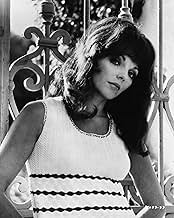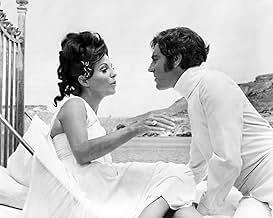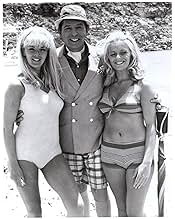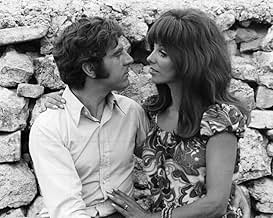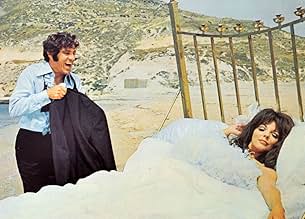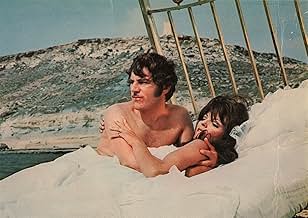Se o Leito Falasse...
Título original: Can Heironymus Merkin Ever Forget Mercy Humppe and Find True Happiness?
AVALIAÇÃO DA IMDb
4,9/10
433
SUA AVALIAÇÃO
Adicionar um enredo no seu idiomaHeironymus Merkin screens an autobiographical movie of his life, growth, and moral decay.Heironymus Merkin screens an autobiographical movie of his life, growth, and moral decay.Heironymus Merkin screens an autobiographical movie of his life, growth, and moral decay.
- Direção
- Roteiristas
- Artistas
- Prêmios
- 1 vitória no total
Tara Newley Arkle
- Thumbelina
- (as Tara Newley)
- Direção
- Roteiristas
- Elenco e equipe completos
- Produção, bilheteria e muito mais no IMDbPro
Avaliações em destaque
I've read some raves and some scathing reviews of this film. The reviewers seem wildly opposed.
What one should remember when viewing this work is the era when it was made. The world was a little different in the late '60s; the war in Vietnam was beginning to be opposed vehemently, nudity and profanity were being more tolerated in films, and a new era of permissiveness was dawning. Films that came out at this time were taking more "avante garde" chances, and there were as many misses as hits.
This film was a mixture of good and bad scenes, but never-the-less an interesting work. The humor in it is somewhat crude, and the music has neither enough polish, or conversely, edge to work completely.
I do remember being entertained by the film, and isn't that the bottom line? Trying to compare it to today's standards is not a valid comparison. No one would try to compare Chaplin's films with Eddie Murphy's. This work is one that will probably stay obscure, because it was more of an experiment than an expression.
Bottom line: A mixture of good and bad comedy, music and philosophy. See it for yourself and see if you can eke out a valid point of view.
What one should remember when viewing this work is the era when it was made. The world was a little different in the late '60s; the war in Vietnam was beginning to be opposed vehemently, nudity and profanity were being more tolerated in films, and a new era of permissiveness was dawning. Films that came out at this time were taking more "avante garde" chances, and there were as many misses as hits.
This film was a mixture of good and bad scenes, but never-the-less an interesting work. The humor in it is somewhat crude, and the music has neither enough polish, or conversely, edge to work completely.
I do remember being entertained by the film, and isn't that the bottom line? Trying to compare it to today's standards is not a valid comparison. No one would try to compare Chaplin's films with Eddie Murphy's. This work is one that will probably stay obscure, because it was more of an experiment than an expression.
Bottom line: A mixture of good and bad comedy, music and philosophy. See it for yourself and see if you can eke out a valid point of view.
After watching this film, I wondered if Anthony Newley thought that this would be his sole chance to direct a major film (which turned out to be true), so he decided togo on a binge with every idea he had at that point . It's in equal parts a mockumentary, a musical, and an homage to Tex Avery cartoons. Newley is the ringleader, Hieronymus Merkin, and he invites us to watch his carnal accomplishments and rise as a singer.
This movie features some fascinating production and costume design, and the beach sets are very unique. The jokes often hit sour notes, but the enthusiasm is contagious. I mean, really, what's better than seeing Joan Collins portray a character named " Polyester Poontang"? If you ever come across this movie, give it a chance.
:)
This movie features some fascinating production and costume design, and the beach sets are very unique. The jokes often hit sour notes, but the enthusiasm is contagious. I mean, really, what's better than seeing Joan Collins portray a character named " Polyester Poontang"? If you ever come across this movie, give it a chance.
:)
As a performer (musical or otherwise), Anthony Newley has always been an acquired taste. His cabaret-born stylings and exaggerated delivery (again, while singing or acting) can either be interpreted as heartfelt or preening. Newley had done nothing on the screen up to this point to justify the jaded, indifferent, Felliniesque "Heironymus Merkin", an autobiographical jumble of vaudeville skits, sex and songs. Newley directed and has the lead; he also co-wrote the script with Herman Raucher, scored the music and produced. Obviously, this project meant a lot to him, but it was shunned upon its release (the ungainly title was most likely no help). The film gives off bad vibrations, as well as the puzzling impression it was made by somebody who hoped to get out of show business. A musical-comedy star reflects on his life upon turning 40 (the age, Merkin tells us, when men's bodies begin to decay); he's guided along his journey by George Jessel (dressed in all-white) and Milton Berle (dressed in suit jackets and shorts, like a leering carnival barker). Newley cavorts with a bevy of women (a handful of whom were featured in a nude Playboy layout, which figured in the advertising), but Merkin/Newley views sex cheerlessly. The women are sex objects to be ogled and then cheated on--until they get pregnant, which leads to the ultimate trap: marriage. While Newley is anxious to show off the bare breasts of his actresses (minus those of wife Joan Collins, who is turned into a shrew), he stops short of celebrating their bodies; in Newley's world, a sex scene is included only to showcase his prowess as a ladies' man. He's not only the star of his own movie, he's the leading man in each of his lovers' movies (the ladies have no personalities--only lascivious names). This self-adoration is probably the reason the film was taken to task by the critics, who called it a megalomaniacal disaster. Is it truly wretched? I would say Newley adopts a certain style from the Masters, which is unfortunately hindered in the end by the lenient editing. There are far too many shots of Newley with his shirt off, or with his shoes off, allowing the camera to admire him. He primps, he sticks out his bottom lip and looks boyish, he dresses as a life-size marionette and collapses, hoping to grab our hearts. The picture isn't a personal triumph because it has been shaped and styled to reveal Anthony Newley as a sad puppet, a crying clown, and the image is so false that nobody--least of all of Newley--could get away with it. *1/2 from ****
This is an extraordinary film. But it's not for everyone, and it must be viewed in it's context.
There was a time when Anthony Newley was one of the biggest stars in the world. With two hit Broadway musicals and a slew of movies under his belt, and songs STILL being covered by today's artists ("Feeling Good" is currently enjoying a popular resurgence courtesy of Michael Buble'"), Universal Studios gave him carte blanche to make any movie he wanted. Newley had already established a proved track record of using his own life as source material. Making this kind of film was a logical next step for him.
In many respects, this film is a masterpiece. It is utterly unique; visually beautiful, it looks like a lucid dream. Newley was a master of symbolism, and the way he illustrates different levels of reality and different states of consciousness is nothing short of brilliant. Highly "Jungian", this film is meant be viewed and interpreted like a dream. Many reviewers have lambasted "Heironumus" for it's use of symbolism, but on the contrary, that is the beauty and magic of the film. Anyone familiar with the Western Hermetic Tradition will delight in the eloquence with which this movie speaks. It cannot be an accident that "Heironymus" was filmed in Malta, the home of the Knights Templar. It makes one question how deeply into the occult Newley must have been.
PLOT SUMMARY: Heironymus Merkin, a major star, is making a film about his own life, told as a fairy tale/epic myth. He is screening it for his mother and two toddler children. It is his intent that his children know the truth about who their father is, warts and all. The film-within-the-film is still in production, and Heironymus battles with the studio, writers, and critics for the integrity of his personal truth.
The film is:
about mid-life crisis
an exposition of internalized toxic shame
an examination of the repetition compulsion
A confession
a cry for help
a treatise on the unreality of life
a rare look at celebrity-hood from a celebrity's point of view
a self-portrait of a sex-addict
a dissertation on erotic mania
AND it's a musical-comedy.
The movie is many things, confusing, because Newley was himself confused. Then again, aren't we all to some degree? The greatest thing about "Heironymus" is all the questions it brings up. It inspires deep process, and that is what makes it Art, and a true gift to the world.
I am committed to helping this film finding it's audience.
There was a time when Anthony Newley was one of the biggest stars in the world. With two hit Broadway musicals and a slew of movies under his belt, and songs STILL being covered by today's artists ("Feeling Good" is currently enjoying a popular resurgence courtesy of Michael Buble'"), Universal Studios gave him carte blanche to make any movie he wanted. Newley had already established a proved track record of using his own life as source material. Making this kind of film was a logical next step for him.
In many respects, this film is a masterpiece. It is utterly unique; visually beautiful, it looks like a lucid dream. Newley was a master of symbolism, and the way he illustrates different levels of reality and different states of consciousness is nothing short of brilliant. Highly "Jungian", this film is meant be viewed and interpreted like a dream. Many reviewers have lambasted "Heironumus" for it's use of symbolism, but on the contrary, that is the beauty and magic of the film. Anyone familiar with the Western Hermetic Tradition will delight in the eloquence with which this movie speaks. It cannot be an accident that "Heironymus" was filmed in Malta, the home of the Knights Templar. It makes one question how deeply into the occult Newley must have been.
PLOT SUMMARY: Heironymus Merkin, a major star, is making a film about his own life, told as a fairy tale/epic myth. He is screening it for his mother and two toddler children. It is his intent that his children know the truth about who their father is, warts and all. The film-within-the-film is still in production, and Heironymus battles with the studio, writers, and critics for the integrity of his personal truth.
The film is:
about mid-life crisis
an exposition of internalized toxic shame
an examination of the repetition compulsion
A confession
a cry for help
a treatise on the unreality of life
a rare look at celebrity-hood from a celebrity's point of view
a self-portrait of a sex-addict
a dissertation on erotic mania
AND it's a musical-comedy.
The movie is many things, confusing, because Newley was himself confused. Then again, aren't we all to some degree? The greatest thing about "Heironymus" is all the questions it brings up. It inspires deep process, and that is what makes it Art, and a true gift to the world.
I am committed to helping this film finding it's audience.
People complain that studios don't take chances anymore. Well, although sometimes when they did take a chance they made a masterpiece, they also came up with movies like this! This movie is a mess, so...weird. For much of the running time, it's fascinating to watch its insanity, though eventually it becomes tiring. The only really funny bit is the hilariously tasteless "The Princess and the Donkey" number.
Você sabia?
- CuriosidadesWhen this movie was originally released in 1969, some newspapers refused to advertise it, compelling cinephiles to call up their local theaters to learn the title. A few theaters even temporarily expanded their marquees to fit the entire title. Other theaters truncated the title to "Heironymous Merkin".
- Erros de gravaçãoThe color of Thumbelina's ice-cream cone changes between brown and white and pink.
- Citações
Hieronymous Merkin: Then the Eskimo and the Indian and the cannibal all rush over to the knight and they say, "Your dragon was here and he's looking to terrify you a great deal." And the knight sits there, and he laughs, and he laughs, and he laughs. The moral of the story is, once you understand your own dragon, you don't have to be afraid anymore. See what I mean?
- Cenas durante ou pós-créditosThere are no opening credits. All credits come at the end. The actors take a bow on a custom-made, pastel-painted, portable stage on a beach as their names are credited in jagged, psychedelic print.
- Versões alternativasThere is both an R-rated and an X-rated version. The R-rated version removes a few seconds of the sex scene with Mercy Humppe following the carousel sequence and tones down the suggestiveness of the "Princess and the Donkey" sequence. The X-rated version contains all the footage cut for the R version.
- ConexõesFeatured in This Is Joan Collins (2022)
- Trilhas sonorasPiccadilly Lilly
(uncredited)
Performed by Anthony Newley and Bruce Forsyth
Music by Anthony Newley
Lyrics by Herbert Kretzmer
Principais escolhas
Faça login para avaliar e ver a lista de recomendações personalizadas
Detalhes
- Data de lançamento
- País de origem
- Idioma
- Também conhecido como
- .... Can Heironymus Merkin Ever Forget Mercy Humppe and Find True Happiness?
- Locações de filme
- Malta(beach scenes)
- Empresas de produção
- Consulte mais créditos da empresa na IMDbPro
- Tempo de duração
- 1 h 47 min(107 min)
Contribua para esta página
Sugerir uma alteração ou adicionar conteúdo ausente

